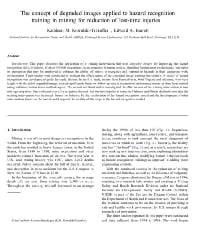Mining Publication: The Concept of Degraded Images Applied to Hazard Recognition Training in Mining for Reduction of Lost-Time Injuries
Original creation date: July 2003
Authors: KM Kowalski-Trakofler, EA Barrett
This paper discusses the application of a training intervention that uses degraded images for improving the hazard recognition skills of miners. NIOSH researchers, in an extensive literature review, identified fundamental psychological principles on perception that may be used to enhance the ability of miners to recognize and respond to hazards in their dangerous work environment. Three studies were conducted to evaluate the effectiveness of the degraded-image training intervention. A model of hazard recognition was developed to guide the study. In the first study, miners from Pennsylvania, West Virginia, and Alabama who were taught with the aid of degraded images scored significantly better on followup hazard recognition performance measures than those trained using traditional instructional methodologies. The second and third studies investigated the effectiveness of the training intervention at two mining companies. Data collected over a 3-year period showed that lost-time injuries at mines in Alabama and Illinois declined soon after the training intervention was instituted. Further exploration of the hazard recognition model and the development of other interventions based on the model could support the validity of the steps in the hazard recognition model.
